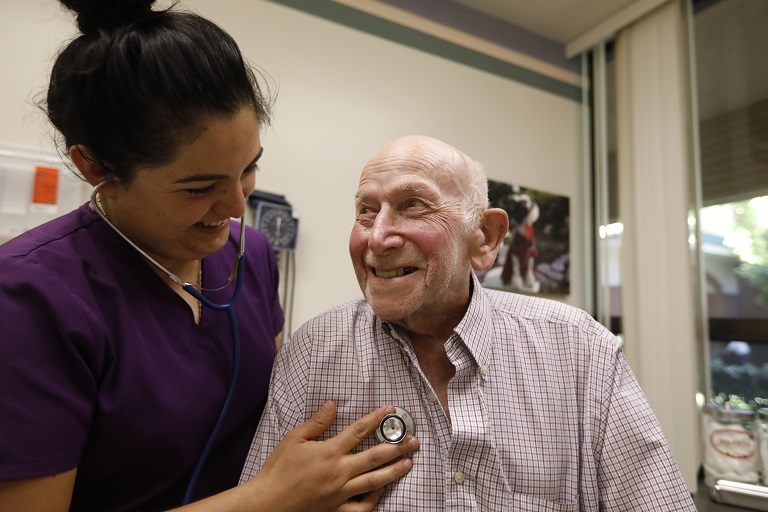LeadingAge’s ongoing collaboration with the White House and the Department of Health & Human Services (HHS) to increase uptake of bivalent boosters among nursing home residents nationwide kicked off last November, with the launch of the All Hands on Deck campaign.
Our participation includes tracking and submitting to HHS weekly reports demonstrating nonprofit aging services providers’ progress. The news is positive, as data submitted January 20 shows: 64% of residents at LeadingAge-member nursing homes have had bivalent boosters, which is well above the average (49.32%) for all U.S. nursing home residents and far higher than both the general population (15%) and Americans 65 years of age or older (40%). The LeadingAge member nursing homes’ booster percentage increased by 9.2 percentage points between November 13 and January 1, and our efforts are aimed at continued improvement.
We’ve talked to LeadingAge members that have exceeded expectations, reaching bivalent booster percentages well above 80% among skilled nursing residents, and asked what strategies worked.
Building trust with attention to detail and infection prevention: At Eskaton Care Center Greenhaven, a skilled nursing and rehabilitation community in Sacramento, CA, over 90% of the community’s 102 residents and 236 staff are up to date on COVID vaccines. Administrator Heather Craig credits her staff’s focus on infection prevention and control from the very beginning of the pandemic as a factor in getting buy-in on vaccines. Craig is also an active participant in the Sacramento County Health Care Coalition, created under the federal Hospital Preparedness Program. Not only did the Coalition help Eskaton Greenhaven procure adequate supplies of PPE during the worst days of the pandemic, but the best practices it identifies have helped the provider stay on top of the latest COVID protocols.
Transparent, regular communication to residents, families, and staff: At Clark-Lindsey Village, Urbana, IL, where all 82 nursing home residents have received bivalent boosters, constant education has kept the importance of vaccination at the forefront of communications. From the beginning of the pandemic, Vice President of Health Services Rikki Brady has sent weekly letters to family members and the community to keep them informed, and also included links or other information about where the families of residents and staff could go for their own vaccinations. In addition, executive staff and board members are all active in promoting a message of safety and vaccination to the entire community.
Mark Beggs, president and CEO of Edenwald, a life plan community in Towson, MD, also credits consistent, clear messaging as the key to his organization’s high numbers. Edenwald’s promotion of vaccination began with a simple, repeatable message that it is simply the right thing to do. Edenwald’s skilled nursing bivalent vaccination rate is above 85% (some residents have been exempted for medical reasons). He also reiterates the message that the community has returned to normal life in many ways in the last year–opening up dining and activities and making masks optional for long periods of time–and that doing so has only been possible because of high vaccination levels.
At Eskaton Greenhaven, an automated phone dialing system has been used throughout the pandemic to give updates to residents, families, and staff at least weekly. “Even if there wasn’t COVID In the building, we were reporting on the state and county COVID positivity rates, to keep focused on infection control,” says Craig.
Proactive, frequent scheduling of on-site vaccine clinics: All of these members have made it easy for residents and staff to get vaccinated by hosting multiple on-site clinics. At Clark-Lindsey Village, early vaccine clinics were done in partnership with Walgreens, and another local pharmacy has managed more recent clinics. “Any time I get a group of three to ten people together, they’ll come out and do a clinic,” says Brady.
Eskaton Greenhaven was one of the first providers in Sacramento County to hold a clinic, and subsequent clinics for every round of boosters. Because many residents are Kaiser Permanente clients, Kaiser has sent its own teams to the community to give vaccines as well. Edenwald has also held clinics with each round of boosters, and since it has a vaccine mandate in place for staff, has also scheduled clinics to align with mandate deadlines.
Modeling of healthy behaviors: Leaders at these organizations have visibly been the first to get their own vaccinations. At Eskaton Greenhaven, Craig was first in line for the vaccine. Eskaton’s regional vice president of health care also came to the home for his vaccine, as did some of the doctors who visit the community. At Clark-Lindsey Village, board members join the executive team in receiving and promoting vaccines. Recently, Brady invited the head of the local public health department to give a presentation for residents and staff on the importance of vaccination and boosters. “Sometimes, I think it helps to hear from an outside expert,” she says.
Learn more about the All Hands on Deck campaign.

 Shutdown Week Three: Impact of Ongoing Closure on Affordable Housing
Shutdown Week Three: Impact of Ongoing Closure on Affordable Housing


